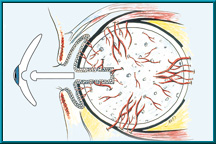Surgical Procedure
Surgical Procedure
The Bio-eye Hydroxyapatite Orbital Implant is surgically placed within the orbit at the time the eye is removed, and the tissues are closed over the implant. A temporary conformer is then placed over the implant and under the eyelids to maintain the space for the artificial eye.
Six to eight weeks later, a visit is made to an ocularist. This highly skilled specialist will create a detailed artificial eye-often astonishing in its lifelike appearance-that exactly matches your natural eye. The artificial eye fits over the implant and under the eyelids, and will move as the implant moves or “tracks” along with the natural eye.

Figure 1. Bio-eye orbital implant after tissue ingrowth (optional peg system shown).
If further movement is desired, your ophthalmologist can perform a simple procedure to connect the artificial eye to the implant, by means of a peg (Fig. 1). In this optional procedure, a hole is placed in the implant and a peg is inserted into the hole. Your ocularist then modifies the back of the artificial eye to accept the head of the peg, thus forming a ball-and-socket joint.
The peg-fitting procedure can only be performed after the implant has had time to fill with tissue from the orbit–usually about six months after implantation. A bone scan or magnetic resonance imaging (MRI) test can confirm whether the implant is ready to accept a peg. These tests, as well as the peg-fitting procedure, are usually painless.
Once your ocularist has properly fit the artificial eye, the full benefits of the Bio-eye orbital implant will be available to you. Of course, the final results in each case will vary depending on the condition of the orbit, muscles, and surrounding tissues.
Next
Patient Information Video

